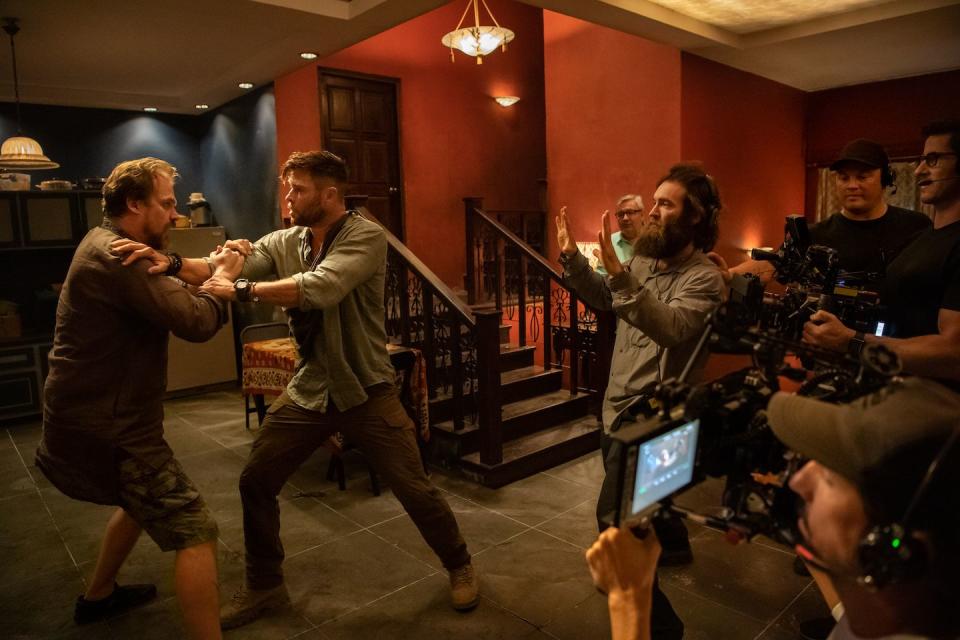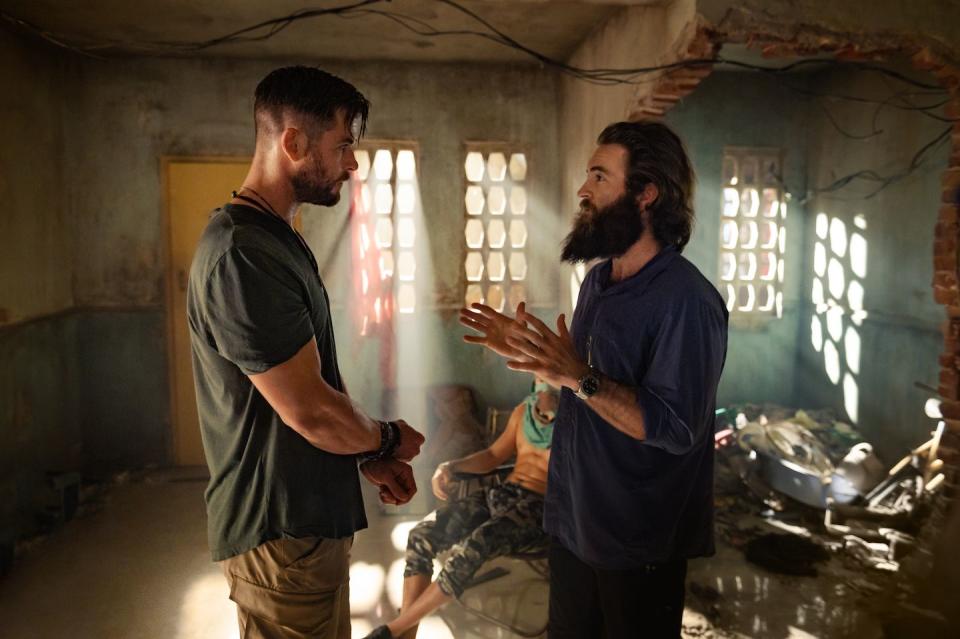Behind the Scenes of Chris Hemsworth's Wildest 'Extraction' Stunts
When Sam Hargrave first met the Russo Brothers direction team on the set of the 2012 Marvel film The Avengers, he was there to don the Cap's iconic helmet and shield as Chris Evans' stunt double. He'd been a stuntman for the better part of a decade, but his entry into the Marvel Cinematic Universe was the beginning of something else. He continued to play Evans' stunt double on screen, but was also tapped as stunt coordinator for movies all over the superhero spectrum—including Captain America: Civil War, Avengers: Infinity War, Avengers: Endgame, The Wolverine, Suicide Squad, and Deadpool 2. He was a fight choreographer for Atomic Blonde, in which Charlize Theron dropkicks her way into the pantheon of action stars in a gruelingly-long fight sequence. He took up the role of second unit director on many of those movies too, and had talked to the Russos, now his mentors and decade-long friends, about making his own directorial debut. They brought him the script written by Joe Russo for Extraction, an action-packed thriller based on a graphic novel. (The Russos helped write the story for that too.)
In the movie, Chris Hemsworth plays Tyler Rake, a mercenary with a death wish and an assignment to extract the son of an Indian crime lord kidnapped by a rival cabal. The movie, which drops on Netflix today, is a frenetic race through the streets of Ahmedabad, India but with an emotional through-line that the Russos wanted to see even in its epic fight scenes. They tapped Hargrave because they know his work intimately, and knew he could bring emotion to his authentic approach to action. The results are a seemingly uninterrupted 12-minute-long fight sequence, authentic Hemsworth tears, and just the kind of pulse-racing our sedentary bodies we need right now.
So to mark the release of Extraction, Hargrave talked to Men's Health to break down what really goes into an epic action sequence, how Chris Hemsworth ranks among MCU actors in the fight scene department, and the time he and his fellow stunt double brother both donned Captain American costumes and duked it out.
The big set-piece of the movie is a nearly 12-minute-long action sequence that you call "The Oner" because it's made to look like one grueling, continuous shot. How much time and work goes into just that one seamless scene?
That particular sequence took us probably four or five months from conception to completion, because it wasn't written that way originally. It was a big chase, exciting on the page, but once we decided to shoot it as an apparent one-take it became something that would be very ambitious to pull off. And so we had to make sure that everybody was on the same page—there were a lot of rehearsals, a lot of location scouts, taking the stunt team to the locations to make sure the action fit the space and fit the characters.
So the preparation was very technical and logistical. And then we had actors rehearsing to make sure they knew all the moves. We wanted to focus on keeping our actors on camera as much as possible, not relying on stunt doubles and quick cuts to hide things. So they needed to be well prepared, and that kind of stuff takes time. We ended up shooting for, I think, 10 days in sequence. It was really gratifying to finish something like that.

The sequence reminded me of another outstanding sequence you choreographed for Atomic Blonde. Both were long and looked seamless, but I was more struck by the controlled messiness of the fighting. It's not modern dance-as-action. Both scenes involved a lot of struggling, getting winded, grabbing at each other, and clawing your way back up. How do you get that kind of authenticity in a fight scene?
Part of the benefit of doing a longer, extended action sequence is that your performers aren’t just doing it for four or five minutes before you cut and they get to rest. By the time you get to the end, there's not a lot of acting required—the performers are really tired. So I just tell them to play it real. If they got to take a second, we built in beats. If you watch a UFC or boxing match, there's a lot of resting going on. So part of the balance is to not rest so long that people get bored and tune out, but you still want to be real to that scenario—feel the pain, feel the recovery time, feel what the characters are going through in that moment.
Chris Hemsworth is a paragon of fitness. Did he struggle with any part of it?
To hear him describe the Oner—preparing for it and shooting it—he says it’s one of the hardest things he's ever done for a movie. And as fit as he is, fitness is all very relative. If somebody runs a marathon, they may have a hard time lifting. If somebody’s an Olympic sprinter, they may not be able to do grappling. Chris is always in shape, it's just the variety and amount of things he had to do—you're running up and down stairs, you're grappling, you're crawling on the ground, you're throwing punches, kicks—they’re all very different ways of using your body. Overall, it was just very strenuous, but he trained hard for it. The only things he wouldn’t do were the things we wouldn't allow him to do for insurance reasons. The stuntman had to get hit by a car, for example. But all the fighting, the running, the action that you see is Chris Hemsworth. He showed up every day with a smile and he made it fun.
One fight scene makes creative use of a rake. Was that in the script, or added in when mapping out the fight?
No, that was an addition. There was an early comment online, something like, "If Tyler Rake uses a rake to kill somebody, I'm going to lose my mind." So it was actually inspired by a fan of the genre. I thought, "You know, that's actually kind of brilliant." If that's the things that fans are looking for, then we should put it in there.
There's a scene when Chris jumps off a cliff and takes a very long drop into some water below. Did he do that himself?
That was a mixture of a lot of different camera tricks, truthfully. The location we found that had the cliff face that we liked, but the water there was not safe. So it was a blend of Hemsworth, who stepped off the cliff and jumped—quite a big jump, down 10 or 12 feet—down to a mat covered in blue screen. That was blended with a shot of his stunt double, Bobby Holland Hanton, landing into a body of water. But the most impressive thing to me about that whole sequence was the underwater shots. Hemsworth shot that in a water tank on a stage, but he would hold his breath for over two and a half minutes. We were counting it down. At two and a half minutes, we said, "Okay, we've got the shot twice already. Why don't you come on up?” He just seemed to be in a relaxed, meditative state.
Well, that's above and beyond.
That just describes his attitude to the whole project: above and beyond. He was never satisfied with good enough, he always wanted to give his best, and he showed up every day and went above and beyond the call of duty.
You've works on stunts and fight scenes with a lot of big names. Who takes to it most naturally?
Charlize Theron puts in an incredible amount of work and has a very strong inclination toward action. Hugh Jackman is another one who is very, very talented. Chris Evans—another one of the Chrises—is very good too. I've been fortunate in my career to work with super talented actors, but based on how closely we worked together, the conversations we had, and how much I feel I pushed him, I think Hemsworth takes the cake.
Were there any actors who didn't take to is so naturally, but really put in the work in a way that impressed you?
I think one of my favorite stories of that is probably Scarlett Johansson. She put in the work, she has the work ethic, and in her own solo Black Widow movie, which hopefully comes out soon, you’ll be able to see that. She's become a symbol of what a female action hero is, and that’s a testament to her hard work and discipline and all the time she puts into it. She’s taken it to the next level.

Your brother Daniel Hargrave came on as Chris Evans' stunt double for Infinity War and Endgame after you hung up your cap. But then you put the Captain America costume on one more time for a fight scene in Endgame where Cap goes back in time and fights himself, which meant the Hargrave brothers were duking it out for that scene. How did it feel to work with your brother on that?
That was one of the most amazing experiences in my film career to date. Growing up together back in North Carolina, my brother and I would make short movies together and put together fight scenes. Then he went into the professional baseball world, and I went into my world, into movies. When he got injured and wasn't able to continue playing, I said, "If you want to come try this out, there might be a job available." And to his credit, he put in a lot of hard work and became the best person for the job [of Chris Evans’s stunt double]. He earned it.
I was directing the sequence, and my father was there for the four days we were shooting it, so I deciding to come out of retirement, so to speak. I shaved the beard, cut the hair, and went on camera again. It was my full circle moment in the Marvel Universe because I started on the first Avengers film, and now I was wearing that same 2012 Captain America suit. And to do it all opposite my brother, to get to fight with him on camera and to relive those childhood memories on the set of the biggest movie ever made, one that the whole world will be watching—it was just a very special, meaningful time for me.
That scene was pretty pivotal. With all of Marvel's secrecy, did you even know the context of what you were shooting?
There is a lot of secrecy in the Marvel Universe, but there are different levels of access and certain scripts. There's a blue script that some people get. Then there’s a red script, that tells you what’s actually happening, that only certain people get. And you read the red script while locked in a room with two Marvel security guards out front. I could read those scripts because I was technically a [second unit] director and I needed to communicate to someone like Chris Evans: “This is where we're coming from, this where we're going, here's what you want.”
How have you kept all the "red script" spoilers to yourself all these years?
You get practiced at it. You sign your NDA, they said, "Don't talk about it," so you don't. Being a fan of the Marvel Universe myself makes it a little easier. In a way, I wish I didn't know. So you hold onto the secrets because you don’t want to spoil the surprise.
You Might Also Like

